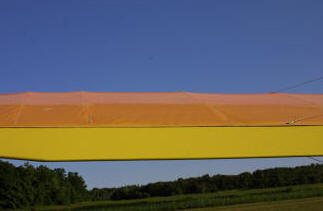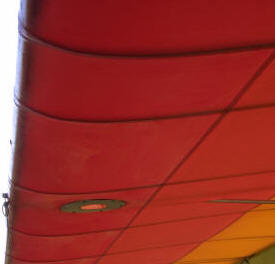|
Question:
How can one tell if their old sails are still airworthy?
My sails are a bit bleached, but seem quite strong. Is there a home built
device that will test
the fabric?
Thanks,
Buzzman:
Sail condition can be quite deceiving unless a proper test
is performed. The fading of the sail definitely means
degradation has occurred. If the blacks are grey and the
reds are close to pink, the sail is shot and needs
replaced.
However, there are chemicals available
to rejuvenate the colors which can mislead the eyeball
type tests, since the faded colors means a bad sail but
so-so colors don't mean a good one.
The other concern is the thread used in the sail. Quality
sails will use thread that is immune to UV compared to the
basic dacron material. A sail made with non- stabilized
thread will fail often in the seams while in use.
Often , an accident involving the wings, will make large
tears in the sail, other than puncture tears. Any sail
which exhibits such damage is not airworthy. A good sail
will tear only when severely punched by jagged material
from the accident, not due to the shear loads from the
impact with an object.
The best place to check a sail is in an existing slit
where battens enter pockets. If the existing slit can be
propagated with little effort the sail is shot. Another
method is to give the sail a good solid poke with a finger
in a suspect area. If it tears, you will not hurt a 'good
set of sails'.
 Maule
Fabric tester Maule
Fabric tester |
 Belt
tension tester, can be purchased Belt
tension tester, can be purchased
with special end for testing fabric. |
A new piece of material will require almost more effort
than you can muster to get the point to penetrate the
material, the tester will be stopped as the 45 degree area
tries to go through and the actual penetration will make a
sound about like a 22 cal 'short' going off in a small
pistol.
Whenever I sell the tester, I include a sample of new
cloth to allow some comparative testing.
An example may
help
Once, many years ago, when an MX was still hot stuff and I
knew who owned the Quicksilver company, I and two friends
were standing under the wing of an MX that had just flown
into the local airport to be hangared there.
This plane was originally owned by one of the guys there
with me. He commented that the new owner had left the
plane outside for the past year and we all thought it was
just good luck that no storm damage had occurred to the
plane. I had lost several plans to a freak wind storm just
two years before.
The owner had gone into my hangar to get a Coke from the
machine. As the three of us stood there looking the plane
over, the third person, not the previous owner asked "I
wonder what shape the sails are in?". We then discussed
the finger-poking method of testing them. Since the sail
pattern was a Lakeland Custom, mostly white, it didn't
show the typical fading that the darker colors did when
left out for a year.
I noted that the
sails were probably not in real good condition after being
outside for a year and just as I was about to say,
don't my friend did. And his whole fist went
through the sail!!
There we were, standing under the wing, with a major hole
in it. It surprised me and both guys with me.
We then discussed how to tell him that the plane he just
flew in, now had a rather large hole in one wing panel.
As it turned out, he too, had concerns for the sail, and
thanked my friend for 'checking' it for him.
Luckily, I had a stock Lakeland Special MX sail in stock,
and had it installed by the next afternoon.
The proper tool for doing sail tests is a modified belt
tension tester. It has a calibrated spring scale and a
special end which has a 1/16 inch diameter flat area, with
a 45 degree
taper above it. The intention is that the small diameter
will penetrate the sail and the tapered area will not go
on through, just the small 1/16 flay point. This does put
a small hole in the sail, but such a hole in many areas is
more than acceptable.
When using the tester, it is also possible to press until
a minimum reading is obtained and not press until the hole
is made.
Typically, a poor sail can be diagnosed by the faded
colors and the tester will push through easily without
even getting much of a scale deflection.
UV protection don't leave your plane
without it!
Click here for more info!
WHY SHOULD WE BUY
NEW SAILS? DOESN'T DUCT TAPE WORK?
You may not believe
it, but there are people that believe that duct tape will
work to patch and even hold their sails together. This
email was sent to me from a person on one of the many
Weedhopper talk groups. Please read it and remember it
each time you inspect your sails.
Hello Everyone,
I would like to share a story with all Weedhopper Pilots
and other ul interests. It was A day I'll remember for the
rest of my life. I was at a local fly in 4 years ago and
there were 3 Weedhoppers to show up. One of which was a
Weedhopper model C in "DESPERATE" need of new sails. The
sails were dry rotted and had about half a roll of duct
tape on them. After the pilot landed, people couldn't help
but notice the condition of the sails as they were a
tragedy waiting to happen. An uncle of mine at the fly in
offered the guy to take his Weedhopper home on a trailer.
The guy refused the offer of my uncle's and stated " He
had been flying them like this for years"
After the pilot had eaten at the fly in, He decided he was
gonna take her
back up. The plane had a 503 Rotax, He got in and put on
his seatbelt, and
started the engine. At this time the crowd was gathering
to watch him take
off including his son. The pilot held the homemade brake
down while he pushed the throttle to full power. I was
standing directly behind him. He was off the ground in 60
feet. As he climbed to approx 80-100 feet the unthinkable
happened!! THE WHOLE RIGHT SAIL CAME OFF IN MIDAIR.
Everyone was
screaming in terror. The plane hit the ground in a
straight nose down position, motor buried itself about
half a foot in the wet field. The pilot was unconscious,
hurt very badly. Most people, thought he was dead.
Bleeding like a stuck hog, His right leg was over his
head. The impact was so severe it pushed his ankle through
A PAIR OF LEATHER COWBOY BOOTS.
He sustained a broken leg, severe concussion,
shattered ankle, fractured skull, and extensive back
injuries.
The pilot survived
the near fatal crash after months in the hospital. Doctors
amputated his right ankle. All of this over dry rotted
sails.
Please Everyone, Take my advise!!!!
DO NOT FLY WITH AN UNSURE SAIL
CONDITION!!! KEEP SAILS IN GOOD AIRWORTHY SHAPE.
|

 Maule
Fabric tester
Maule
Fabric tester
